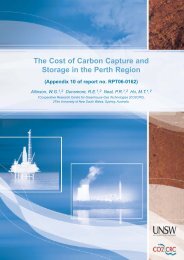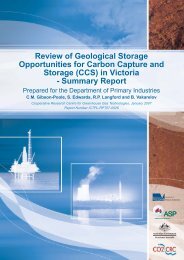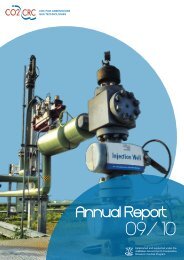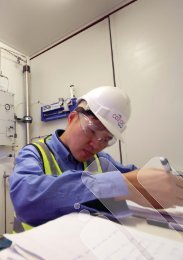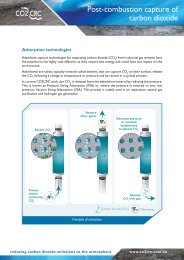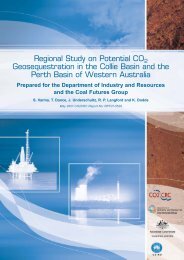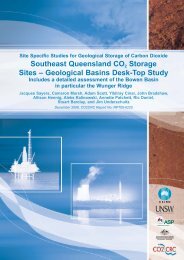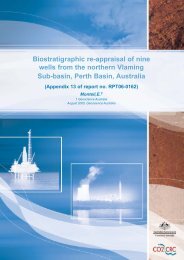Simulation of Geological Storage of Carbon Dioxide in ... - CO2CRC
Simulation of Geological Storage of Carbon Dioxide in ... - CO2CRC
Simulation of Geological Storage of Carbon Dioxide in ... - CO2CRC
Create successful ePaper yourself
Turn your PDF publications into a flip-book with our unique Google optimized e-Paper software.
<strong>Simulation</strong> <strong>of</strong> <strong>Geological</strong> <strong>Storage</strong> <strong>of</strong><strong>Carbon</strong> <strong>Dioxide</strong> <strong>in</strong> the Onshore Perth Bas<strong>in</strong>(Appendix 7 <strong>of</strong> report no. RPT06-0162)Ennis-K<strong>in</strong>g, J. 1 and Wu, G. 11 CSIRO ClaytonOctober 2005, <strong>CO2CRC</strong> report no. RPT05-0087
<strong>Simulation</strong> <strong>of</strong> <strong>Geological</strong> <strong>Storage</strong> <strong>of</strong> <strong>Carbon</strong><strong>Dioxide</strong> <strong>in</strong> the Onshore Perth Bas<strong>in</strong>J. Ennis-K<strong>in</strong>g and G. WuCRC for Greenhouse Gas Technologies,CSIRO Petroleum,Private Bag 10, Clayton South, VIC 3169<strong>CO2CRC</strong> Report No.: RPT05–0087October 7, 2005
Cooperative Research Centre for Greenhouse Gas Technologies (<strong>CO2CRC</strong>)GPO Box 463Level 3, 24 Marcus Clarke StreetCANBERRA ACT 2601Phone: +61 2 6200 3366Fax: +61 2 6230 0448Email: pjcook@co2crc.com.auWeb: www.co2crc.com.auReference: Ennis-K<strong>in</strong>g, J, Wu, G, 2005. <strong>Simulation</strong> <strong>of</strong> <strong>Geological</strong> <strong>Storage</strong> <strong>of</strong><strong>Carbon</strong> <strong>Dioxide</strong> <strong>in</strong> the Onshore Perth Bas<strong>in</strong>. CSIRO Petroleum. <strong>CO2CRC</strong>Report No. RPT05-0087c○<strong>CO2CRC</strong> 2005Unless otherwise specified, the Cooperative Research Centre for GreenhouseGas Technologies (<strong>CO2CRC</strong>) reta<strong>in</strong>s copyright over this publicationthrough its commercial arm, Innovative <strong>Carbon</strong> Technologies Pty Ltd. Youmust not reproduce, distribute, publish, copy, transfer or commercially exploitany <strong>in</strong>formation conta<strong>in</strong>ed <strong>in</strong> this publication that would be an <strong>in</strong>fr<strong>in</strong>gement<strong>of</strong> any copyright, patent, trademark, design or other <strong>in</strong>tellectual propertyright. Requests and <strong>in</strong>quiries concern<strong>in</strong>g copyright should be addressedto the Communication Manager, <strong>CO2CRC</strong>, GPO Box 463, CANBERRA,ACT, 2601. Telephone: +61 2 6200 3366.
Contents1 Executive Summary 12 Introduction 23 <strong>Simulation</strong> capabilities 34 <strong>Simulation</strong> model 44.1 Absolute permeability . . . . . . . . . . . . . . . . . . . . . . 44.2 Vertical permeability . . . . . . . . . . . . . . . . . . . . . . . 44.3 Relative permeability . . . . . . . . . . . . . . . . . . . . . . . 54.4 Temperature, pressure and sal<strong>in</strong>ity . . . . . . . . . . . . . . . 54.5 Model parameters . . . . . . . . . . . . . . . . . . . . . . . . . 55 Results 75.1 Radial grid with effective vertical permeability . . . . . . . . . 75.2 3D grid with explicit flow barriers . . . . . . . . . . . . . . . . 116 Conclusions 24i
List <strong>of</strong> Figures1 Vertical cross-section <strong>of</strong> gas saturation <strong>in</strong> the base case for theradial model after 20 years <strong>of</strong> <strong>in</strong>jection at 1 million tonnes peryear. The radial distance is 1000m. The top <strong>of</strong> the modelcorresponds to a depth <strong>of</strong> 1200m, and the bottom to 2000m.Red corresponds to high gas saturation and blue to zero gassaturation. . . . . . . . . . . . . . . . . . . . . . . . . . . . . . 72 Vertical cross-section <strong>of</strong> gas saturation <strong>in</strong> the base case for theradial model 180 years after the end <strong>of</strong> the <strong>in</strong>jection phase.The radial distance is 1000m. The top <strong>of</strong> the model correspondsto a depth <strong>of</strong> 1200m, and the bottom to 2000m. Redcorresponds to high gas saturation and blue to zero gas saturation.. . . . . . . . . . . . . . . . . . . . . . . . . . . . . . . 83 Vertical cross-section <strong>of</strong> gas saturation <strong>in</strong> the base case for theradial model 1980 years after the end <strong>of</strong> the <strong>in</strong>jection phase.The radial distance is 1000m. The top <strong>of</strong> the model correspondsto a depth <strong>of</strong> 1200m, and the bottom to 2000m. Redcorresponds to high gas saturation and blue to zero gas saturation.. . . . . . . . . . . . . . . . . . . . . . . . . . . . . . . 84 Vertical cross-section <strong>of</strong> gas saturation <strong>in</strong> the high permeabilitycase for the radial model after 20 years <strong>of</strong> <strong>in</strong>jection at 1million tonnes per year. The radial distance is 1000m. Thetop <strong>of</strong> the model corresponds to a depth <strong>of</strong> 1200m, and thebottom to 2000m. Red corresponds to high gas saturationand blue to zero gas saturation. . . . . . . . . . . . . . . . . . 95 Vertical cross-section <strong>of</strong> gas saturation <strong>in</strong> the high permeabilitycase for the radial model 180 years after the end <strong>of</strong> the<strong>in</strong>jection phase. The radial distance is 1000m. The top <strong>of</strong> themodel corresponds to a depth <strong>of</strong> 1200m, and the bottom to2000m. Red corresponds to high gas saturation and blue tozero gas saturation. . . . . . . . . . . . . . . . . . . . . . . . . 106 Vertical cross-section <strong>of</strong> gas saturation <strong>in</strong> the high permeabilitycase for the radial model 1980 years after the end <strong>of</strong> the<strong>in</strong>jection phase. The radial distance is 1000m. The top <strong>of</strong> themodel corresponds to a depth <strong>of</strong> 1200m, and the bottom to2000m. Red corresponds to high gas saturation and blue tozero gas saturation. . . . . . . . . . . . . . . . . . . . . . . . . 10ii
7 Vertical cross-section <strong>of</strong> one realisation <strong>of</strong> the stochastic distribution<strong>of</strong> shales for a 3D grid. The lateral width is 3000m.The shale units are 200m by 100m laterally. The top <strong>of</strong> themodel corresponds to a depth <strong>of</strong> 1200m, and the bottom to2000m. The shales are <strong>in</strong> red, the Cattamarra formation is <strong>in</strong>yellow, the Cadda is <strong>in</strong> olive, and the Yarragadee is <strong>in</strong> green. . 118 Horizontal cross-section at a depth <strong>of</strong> 1710m (bottom <strong>of</strong> theCadda formation) <strong>of</strong> one realisation <strong>of</strong> the stochastic distribution<strong>of</strong> shales for a 3D grid. The lateral width is 3000m <strong>in</strong>both directions. The shale units are 200m by 100m laterally.The shales are <strong>in</strong> red . . . . . . . . . . . . . . . . . . . . . . . 129 Vertical cross-section <strong>of</strong> gas saturation for a 3D grid with astochastic distribution <strong>of</strong> flow barriers after 20 years <strong>of</strong> <strong>in</strong>jectionat 1 million tonnes per year. The lateral width is 3000m.The shale units are 200m by 100m laterally. The top <strong>of</strong> themodel corresponds to a depth <strong>of</strong> 1200m, and the bottom to2000m. Red corresponds to high gas saturation and blue tozero gas saturation. . . . . . . . . . . . . . . . . . . . . . . . . 1310 Horizontal cross-section at a depth <strong>of</strong> 1710m <strong>of</strong> gas saturationfor a 3D grid with a stochastic distribution <strong>of</strong> flow barriersafter 20 years <strong>of</strong> <strong>in</strong>jection at 1 million tonnes per year. Thelateral width is 3000m. The shale units are 200m by 100mlaterally. Red corresponds to high gas saturation and blue tozero gas saturation. . . . . . . . . . . . . . . . . . . . . . . . . 1411 Vertical cross-section <strong>of</strong> gas saturation for a 3D grid with astochastic distribution <strong>of</strong> flow barriers 180 years after the end<strong>of</strong> <strong>in</strong>jection. The lateral width is 3000m. The shale units are200m by 100m laterally. The top <strong>of</strong> the model corresponds toa depth <strong>of</strong> 1200m, and the bottom to 2000m. Red correspondsto high gas saturation and blue to zero gas saturation. . . . . 1512 Horizontal cross-section at a depth <strong>of</strong> 1510m <strong>of</strong> gas saturationfor a 3D grid with a stochastic distribution <strong>of</strong> flow barriers at200 years after 20 years <strong>of</strong> <strong>in</strong>jection at 1 million tonnes peryear. The lateral width is 3000m. The shale units are 200mby 100m laterally. Red corresponds to high gas saturation andblue to zero gas saturation. . . . . . . . . . . . . . . . . . . . . 16iii
13 Vertical cross-section <strong>of</strong> gas saturation for a 3D grid with astochastic distribution <strong>of</strong> flow barriers 920 years after the end<strong>of</strong> <strong>in</strong>jection. The lateral width is 3000m. The shale units are200m by 100m laterally. The top <strong>of</strong> the model corresponds toa depth <strong>of</strong> 1200m, and the bottom to 2000m. Red correspondsto high gas saturation and blue to zero gas saturation. . . . . 1714 Vertical cross-section <strong>of</strong> gas saturation for a 3D grid with astochastic distribution <strong>of</strong> flow barriers 180 years after the end<strong>of</strong> <strong>in</strong>jection. The ratio <strong>of</strong> vertical to horizontal permeability<strong>in</strong> the sand units is 0.5. The lateral width is 3000m. Theshale units are 200m by 100m laterally. The top <strong>of</strong> the modelcorresponds to a depth <strong>of</strong> 1200m, and the bottom to 2000m.Red corresponds to high gas saturation and blue to zero gassaturation. . . . . . . . . . . . . . . . . . . . . . . . . . . . . . 1715 Horizontal cross-section at a depth <strong>of</strong> 1510m <strong>of</strong> gas saturationfor a 3D grid with a stochastic distribution <strong>of</strong> flow barriersafter 20 years <strong>of</strong> <strong>in</strong>jection at 1 million tonnes per year. Theratio <strong>of</strong> vertical to horizontal permeability <strong>in</strong> the sand units is0.5. The lateral width is 3000m. The shale units are 200m by100m laterally. Red corresponds to high gas saturation andblue to zero gas saturation. . . . . . . . . . . . . . . . . . . . . 1816 Vertical cross-section <strong>of</strong> gas saturation for a 3D grid with astochastic distribution <strong>of</strong> flow barriers after 20 years <strong>of</strong> <strong>in</strong>jectionat 1 million tonnes per year. The lateral width is 3000m.The shale units are 500m by 300m laterally. The top <strong>of</strong> themodel corresponds to a depth <strong>of</strong> 1200m, and the bottom to2000m. Red corresponds to high gas saturation and blue tozero gas saturation. . . . . . . . . . . . . . . . . . . . . . . . . 1917 Vertical cross-section <strong>of</strong> gas saturation for a 3D grid with astochastic distribution <strong>of</strong> flow barriers 40 years after the end<strong>of</strong> <strong>in</strong>jection. The lateral width is 3000m. The shale units are500m by 300m laterally. The top <strong>of</strong> the model corresponds toa depth <strong>of</strong> 1200m, and the bottom to 2000m. Red correspondsto high gas saturation and blue to zero gas saturation. . . . . 2018 Horizontal cross-section at a depth <strong>of</strong> 1730m <strong>of</strong> gas saturationfor a 3D grid with a stochastic distribution <strong>of</strong> flow barriers 40years after the end <strong>of</strong> <strong>in</strong>jection. The lateral width is 3000m.The shale units are 500m by 300m laterally. Red correspondsto high gas saturation and blue to zero gas saturation. . . . . 21iv
19 Vertical cross-section <strong>of</strong> gas saturation for a 3D grid with astochastic distribution <strong>of</strong> flow barriers after 20 years <strong>of</strong> <strong>in</strong>jectionat 4 million tonnes per year. The lateral width is 3000m.The shale units are 200m by 100m laterally. The top <strong>of</strong> themodel corresponds to a depth <strong>of</strong> 1200m, and the bottom to2000m. Red corresponds to high gas saturation and blue tozero gas saturation. . . . . . . . . . . . . . . . . . . . . . . . . 2220 Horizontal cross-section at a depth <strong>of</strong> 1710m <strong>of</strong> gas saturationfor a 3D grid with a stochastic distribution <strong>of</strong> flow barriersafter 20 years <strong>of</strong> <strong>in</strong>jection at 4 million tonnes per year. Thelateral width is 3000m. The shale units are 200m by 100mlaterally. Red corresponds to high gas saturation and blue tozero gas saturation. . . . . . . . . . . . . . . . . . . . . . . . . 23List <strong>of</strong> Tables1 Porosity, Permeability and depth for each formation <strong>in</strong> themodel . . . . . . . . . . . . . . . . . . . . . . . . . . . . . . . 62 Ratio <strong>of</strong> vertical to horizontal permeability for each formation<strong>in</strong> the model . . . . . . . . . . . . . . . . . . . . . . . . . . . . 6v
1 Executive SummaryNumerical simulations <strong>of</strong> the onshore Perth Bas<strong>in</strong> were undertaken to assessthe suitability <strong>of</strong> the site for the underground storage <strong>of</strong> carbon dioxide.Given the absence <strong>of</strong> a regional seal between the <strong>in</strong>jection location and theoverly<strong>in</strong>g fresh water, simulations <strong>in</strong>dicated a risk <strong>of</strong> the <strong>in</strong>jected carbondioxide com<strong>in</strong>g <strong>in</strong>to contact with the fresh water, although the time for thisoccur might be long. Thus the site exam<strong>in</strong>ed is unlikely to be suitable forunderground storage.1
2 IntroductionUnderground storage <strong>of</strong> carbon dioxide as a means <strong>of</strong> reduc<strong>in</strong>g atmosphericemissions <strong>of</strong> CO 2 has been exam<strong>in</strong>ed both theoretically and practically overthe last decade (see Ennis-K<strong>in</strong>g and Paterson (2002) for a review <strong>of</strong> the recentliterature). There is also a large amount <strong>of</strong> relevant research and field experience<strong>in</strong> the energy sector e.g. natural gas storage <strong>in</strong> deep sal<strong>in</strong>e formations,carbon dioxide <strong>in</strong> enhanced oil recovery, and acid gas <strong>in</strong>jection. It is clearfrom this experience that underground storage <strong>of</strong> CO 2 is em<strong>in</strong>ently feasible,and <strong>in</strong> fact StatOil is currently sequester<strong>in</strong>g around a million tonnes per year<strong>in</strong>to the Utsira formation below the North Sea (Kongsjorden et al., 1997).Other pilot scale field tests are currently occurr<strong>in</strong>g or are <strong>in</strong> preparation(Hovorka and Knox, 2002; Pawar et al., 2001)In order to assess the suitability <strong>of</strong> a particular site for storage <strong>of</strong> carbondioxide, it is necessary to have an adequate geological model, and then touse this as the basis for a numerical simulation which can predict the behaviour<strong>of</strong> the <strong>in</strong>jected carbon dioxide <strong>in</strong> the subsurface. Unlike a typicaloil-field development, the model needs to be simulated not only dur<strong>in</strong>g the<strong>in</strong>jection phase, but also for at least a few thousand years after <strong>in</strong>jection, <strong>in</strong>order to check on the storage <strong>in</strong>tegrity. In this report, geological <strong>in</strong>formationsupplied by Rick Causebrook and Tess Dance <strong>of</strong> Geoscience Australiawas used to construct a simple simulation model <strong>of</strong> part <strong>of</strong> the onshore PerthBas<strong>in</strong>, discussed <strong>in</strong> section 4. The capabilities <strong>of</strong> the simulator and validationaga<strong>in</strong>st other simulation codes is discussed <strong>in</strong> section 3. Section 5 presentsan analysis <strong>of</strong> the results, and conclusions are given <strong>in</strong> section 6.2
3 <strong>Simulation</strong> capabilitiesThe simulation code used for this study was TOUGH2 Version 2.0, developedby Karsten Pruess and associates at the Earth Sciences Division <strong>of</strong>Lawrence Berkley National Laboratories, California, USA (Pruess et al.,1999). TOUGH2 can handle non-isothermal, multicomponent, multiphaseflow. It was chiefly developed for geothermal reservoir eng<strong>in</strong>eer<strong>in</strong>g, hydrology,and nuclear waste disposal, but has recently been applied by severalgroups to the underground disposal <strong>of</strong> carbon dioxide. A special module forTOUGH2 has been developed, which conta<strong>in</strong>s a high accuracy equation <strong>of</strong>state for carbon dioxide, and improved representations for the solubility <strong>of</strong>carbon dioxide <strong>in</strong> br<strong>in</strong>e. This module, based on the standard EWASG module(Battistelli et al., 1997) allows for a full treatment <strong>of</strong> br<strong>in</strong>es, <strong>in</strong>clud<strong>in</strong>g saltdeposition, and for the solubility <strong>of</strong> water <strong>in</strong> carbon dioxide. Thus formationdry-out can occur near the wellbore i.e. the <strong>in</strong>jection <strong>of</strong> dry carbon dioxidecauses evaporation <strong>of</strong> residual water (and salt deposition) close to the wellbore,so that eventually the residual water saturation there falls to zero. Themodule also accounts for the <strong>in</strong>creased density <strong>of</strong> the formation water upondissolution <strong>of</strong> carbon dioxide, an effect which drives the long-term dissolution<strong>of</strong> carbon dioxide <strong>in</strong> the subsurface (L<strong>in</strong>deberg and Wessel-Berg, 1997;Ennis-K<strong>in</strong>g and Paterson, 2003ab).The <strong>in</strong>ternational code comparison project on underground storage <strong>of</strong>carbon dioxide (Pruess et al., 2002ab) provided a useful means <strong>of</strong> assess<strong>in</strong>gthe performance <strong>of</strong> various simulation packages for the task. The codes<strong>in</strong>cluded commercial <strong>of</strong>fer<strong>in</strong>gs such as Eclipse and CMG-GEM. It was foundthat operator error was responsible for the most serious differences betweensimulation results. When this was corrected, differences then seemed tocentre on the use <strong>of</strong> different formulations for carbon dioxide properties.TOUGH2, when used properly, was found to compare well to a range <strong>of</strong>other codes, and this confirms its suitability for the current project.3
4 <strong>Simulation</strong> model4.1 Absolute permeabilityAs is common <strong>in</strong> sites with few wells, there was not a large amount <strong>of</strong> permeabilitydata available. The supplied data was analysed <strong>in</strong> two ways. First<strong>of</strong> all, arithmetic averages were taken <strong>of</strong> the permeability measurements <strong>in</strong>each formation, and a 90 % confidence <strong>in</strong>terval was estimated for this meanvalue. This gives quite a wide range <strong>of</strong> permeability values. The secondapproach was to attempt to correlate permeability aga<strong>in</strong>st the correspond<strong>in</strong>gporosity values. Insert<strong>in</strong>g the average porosity <strong>in</strong> this correlation then givesa measure <strong>of</strong> the average permeability. This second technique tends to givelower values <strong>of</strong> the permeability due to the fitt<strong>in</strong>g process. In both cases thenet-to-gross values (based on proportion <strong>of</strong> shale) were taken <strong>in</strong>to account <strong>in</strong>upscal<strong>in</strong>g the permeability to the whole formation.4.2 Vertical permeabilityThe proposed <strong>in</strong>jection strategy for this location was to <strong>in</strong>ject deep, and usethe overly<strong>in</strong>g stratigraphy to retard and perhaps trap the upward motion<strong>of</strong> the carbon dioxide due to buoyancy. Previous experience <strong>in</strong>dicates thatthe estimation <strong>of</strong> vertical permeability is one <strong>of</strong> the key uncerta<strong>in</strong>ties <strong>in</strong> themodell<strong>in</strong>g process. Two approaches are considered here.The first approach uses an upscal<strong>in</strong>g technique due to Begg and K<strong>in</strong>g(Beggand K<strong>in</strong>g, 1985). Given a random distribution <strong>of</strong> th<strong>in</strong> lateral flow barrierswith a certa<strong>in</strong> volume fraction, and fixed lateral extent, the average verticalpermeability can be computed from the follow<strong>in</strong>g analytical formula:k vk h=1 − F s(1 + sl/3) 2 (1)where F s is the volume fraction <strong>of</strong> shale, s is the average vertical frequency <strong>of</strong>shales, l is the lateral extent <strong>of</strong> each shale, and k v and k h are the vertical andhorizontal permeabilities. F s and s can be estimated from log <strong>in</strong>formation.Estimation <strong>of</strong> l depends on an understand<strong>in</strong>g <strong>of</strong> the depositional environment.For this site, a width/depth ratio <strong>of</strong> 8-20 was estimated for the shales, giv<strong>in</strong>gan estimated lateral extent <strong>of</strong> 80-500m, with the lateral shape expected tobe elongated. There is an additional factor to be considered <strong>of</strong> the ratio <strong>of</strong>vertical to horizontal permeability (at a f<strong>in</strong>e scale) <strong>of</strong> sand units, which istaken here to be between 0.2 and 0.5.The outcome <strong>of</strong> this first approach is an effective vertical permeability foreach <strong>in</strong>terval. In this k<strong>in</strong>d <strong>of</strong> model, the carbon dioxide rises vertically from4
the <strong>in</strong>jection area (as well as spread<strong>in</strong>g laterally). However the absence <strong>of</strong>actual flow barriers probably underestimates the potential for trapp<strong>in</strong>g alongthe flow path, s<strong>in</strong>ce the residual trapp<strong>in</strong>g mechanism will be more effectiveon a longer flow path.The second approach is that <strong>of</strong> object modell<strong>in</strong>g, where one explicitly generatesstochastic realisations <strong>of</strong> shale distributions which meet the criterion<strong>of</strong> total shale fraction. The advantage <strong>of</strong> this technique is that it captures thelengthen<strong>in</strong>g <strong>of</strong> the flow path due to the tortuous vertical migration, allow<strong>in</strong>gfor greater trapp<strong>in</strong>g at residual gas saturation.4.3 Relative permeabilityThe choice <strong>of</strong> relative permeability curves used to model two phase flow <strong>of</strong>carbon dioxide and water is known to have an important <strong>in</strong>fluence on thelong-term distribution <strong>of</strong> carbon dioxide, especially when vertical migrationoccurs. One <strong>of</strong> the critical parameters is the residual gas saturation on imbibition.Literature data (Suzanne et al., 2003) <strong>in</strong>dicates a wide range <strong>of</strong>values, between 5 % and 40 % can occur, depend<strong>in</strong>g on the local pore structure.No core flood measurements were available at this site, so guided bywork done <strong>in</strong> other bas<strong>in</strong>s, the base case used here is a residual gas saturation<strong>of</strong> 20 %, with one variant case us<strong>in</strong>g 30 %.4.4 Temperature, pressure and sal<strong>in</strong>ityUs<strong>in</strong>g a mean surface temperature <strong>of</strong> 15 C, a fit to the temperature datayielded a gradient <strong>of</strong> 23.6 C/km. In the absence <strong>of</strong> extensive pressure data, atypical hydrostatic pressure gradient was assumed. Well completion reports<strong>in</strong>dicated a sal<strong>in</strong>ity <strong>of</strong> 30,000 ppm below 1340m depth, with a transitionbetween 1340m and 1160m depth to a sal<strong>in</strong>ity <strong>of</strong> 1000 ppm.4.5 Model parametersUs<strong>in</strong>g the techniques discussed above for analys<strong>in</strong>g the geological data, thefollow<strong>in</strong>g model parameters were obta<strong>in</strong>ed for the simulation model. For thepurposes <strong>of</strong> this simulation, the formations are assumed to horizontal and<strong>of</strong> uniform thickness across the area <strong>of</strong> the <strong>in</strong>jection site. Table 1 gives thedepth, the average porosity, and the ranges <strong>of</strong> permeability for each formation,while Table 2 gives the estimates <strong>of</strong> the ratio <strong>of</strong> vertical to horizontalpermeability, as this is used <strong>in</strong> the model with effective vertical permeabilityrather than explicit shale barriers.5
Table 1: Porosity, Permeability and depth for each formation <strong>in</strong> the modelFormation Depth (mSS) Porosity (% ) Perm. (mD) low/av./highYarragadee (Upper) 313-1019 26.8 238/814/1390Yarragadee (Lower) 1019-1725 20.5 7.7/58.5/109Cadda 1725-1914 18.5 119/526/932Cattamarra 1914- 20.7 1.0/8.5/24Table 2: Ratio <strong>of</strong> vertical to horizontal permeability for each formation <strong>in</strong>the modelFormationk v /k h low/average/highYarragadee (Upper) 0.0038/0.018/0.045Yarragadee (Lower) 0.0031/0.016/0.039Cadda 0.0028/0.013/0.034Cattamarra 0.0092/0.026/0.075The <strong>in</strong>jection rate <strong>in</strong> the base case is taken to be 1 million tonnes <strong>of</strong> carbondioxide per year for 20 years (about the scale <strong>of</strong> the Sleipner project), as amedium scale storage operation. The <strong>in</strong>jection strategy is to <strong>in</strong>ject as deepas possible, but with the constra<strong>in</strong>t that adequate permeability is needed togive sufficient <strong>in</strong>jectivity. S<strong>in</strong>ce the average permeability <strong>of</strong> the Cattamarrais too low for sufficient <strong>in</strong>jectivity with a s<strong>in</strong>gle well, the Cadda was chosenfor <strong>in</strong>jection, at a depth <strong>of</strong> around 1760-1900m with a vertical well.The first model (with an effective vertical permeability) was carried outon a radial grid with 95 blocks <strong>in</strong> the radial direction and 110 blocks <strong>of</strong> 20mvertically (10450 blocks <strong>in</strong> all), extend<strong>in</strong>g down from 310m (the top <strong>of</strong> theYarragadee) down to 2510m, <strong>in</strong>to the Cattamarra, and out to 3000m radially.The second model (with explicit flow barriers) was a 3D grid, with 31blocks <strong>of</strong> 100m <strong>in</strong> each lateral direction, and 100 blocks vertically, for a total<strong>of</strong> 96100 blocks. The vertical extent was from 310m down to 2310m, aga<strong>in</strong><strong>in</strong>to the Cattamarra.6
Figure 1: Vertical cross-section <strong>of</strong> gas saturation <strong>in</strong> the base case for theradial model after 20 years <strong>of</strong> <strong>in</strong>jection at 1 million tonnes per year. Theradial distance is 1000m. The top <strong>of</strong> the model corresponds to a depth <strong>of</strong>1200m, and the bottom to 2000m. Red corresponds to high gas saturationand blue to zero gas saturation.5 Results5.1 Radial grid with effective vertical permeabilityThe base case will be the average values <strong>of</strong> the absolute permeability andthe average values <strong>of</strong> the ratio <strong>of</strong> vertical to horizontal permeability <strong>in</strong> eachformation. For this base case, Figure 1 shows a vertical cross-section <strong>of</strong> thedistribution <strong>of</strong> gas saturation <strong>in</strong> the radial model after 20 years <strong>of</strong> <strong>in</strong>jection.The pressure gradient due to <strong>in</strong>jection causes the carbon dioxide to spreadout laterally much more than vertically, s<strong>in</strong>ce the vertical permeability isonly a small fraction <strong>of</strong> the horizontal permeability. Thus most <strong>of</strong> the carbondioxide is still conta<strong>in</strong>ed <strong>in</strong> the Cadda formation at this stage.After <strong>in</strong>jection ceases, the driv<strong>in</strong>g force is now buoyancy, and the <strong>in</strong>jectedcarbon dioxide rises vertically. Figure 2 shows the distribution <strong>of</strong> gas saturation180 years after the end <strong>of</strong> the <strong>in</strong>jection phase. There is slow verticalmigration <strong>in</strong>to the lower part <strong>of</strong> the overly<strong>in</strong>g Yarragadee formation. Residualgas trapp<strong>in</strong>g will reduce the amount <strong>of</strong> mobile carbon dioxide, eventuallystopp<strong>in</strong>g the vertical migration. Fig. 3 shows the result 1980 years afterthe end <strong>of</strong> the <strong>in</strong>jection phase. In this case the vertical motion <strong>of</strong> the carbondioxide has stopped well below the fresh water <strong>in</strong>terface that is around 1200mdepth.7
Figure 2: Vertical cross-section <strong>of</strong> gas saturation <strong>in</strong> the base case for the radialmodel 180 years after the end <strong>of</strong> the <strong>in</strong>jection phase. The radial distance is1000m. The top <strong>of</strong> the model corresponds to a depth <strong>of</strong> 1200m, and thebottom to 2000m. Red corresponds to high gas saturation and blue to zerogas saturation.Figure 3: Vertical cross-section <strong>of</strong> gas saturation <strong>in</strong> the base case for theradial model 1980 years after the end <strong>of</strong> the <strong>in</strong>jection phase. The radialdistance is 1000m. The top <strong>of</strong> the model corresponds to a depth <strong>of</strong> 1200m,and the bottom to 2000m. Red corresponds to high gas saturation and blueto zero gas saturation.8
Figure 4: Vertical cross-section <strong>of</strong> gas saturation <strong>in</strong> the high permeabilitycase for the radial model after 20 years <strong>of</strong> <strong>in</strong>jection at 1 million tonnes peryear. The radial distance is 1000m. The top <strong>of</strong> the model corresponds toa depth <strong>of</strong> 1200m, and the bottom to 2000m. Red corresponds to high gassaturation and blue to zero gas saturation.However the uncerta<strong>in</strong>ty <strong>in</strong> the permeability estimation both horizontallyand vertically presents a risk that the base case may be far from reality. Acontrast<strong>in</strong>g case is to use the high estimates <strong>of</strong> horizontal permeability, comb<strong>in</strong>edwith a value <strong>of</strong> 0.1 for the ratio <strong>of</strong> vertical to horizontal permeability.Fig. 4 shows the gas saturation <strong>in</strong> this case at the end <strong>of</strong> the <strong>in</strong>jection phase.Compar<strong>in</strong>g to Fig. 1, the lateral extent is greater due to the higher absolutepermeability, and the vertical migration is well <strong>in</strong>to the lower part <strong>of</strong> theYarragadee formation. When 200 years has elapsed s<strong>in</strong>ce the start <strong>of</strong> <strong>in</strong>jection,the carbon dioxide has made significant vertical progress, as <strong>in</strong>dicatedby Fig. 5, where gas saturation is seen <strong>in</strong> the upper part <strong>of</strong> the Yarragadeeformation. At this stage, only a small proportion <strong>of</strong> the carbon dioxide isstill mobile, as evidenced by Fig. 6, which shows that after 2000 years, thecarbon dioxide has not moved much further upwards than it had a 200 years.Nevertheless, <strong>in</strong> this high permeability case (which from the po<strong>in</strong>t <strong>of</strong> view<strong>of</strong> conta<strong>in</strong>ment, is a “worst case”), the carbon dioxide is much closer to thefresh water <strong>in</strong>terface, and this <strong>in</strong>dicates a greater risk for loss <strong>of</strong> conta<strong>in</strong>mentor undesirable effects on the potable water <strong>in</strong> overly<strong>in</strong>g aquifers.9
Figure 5: Vertical cross-section <strong>of</strong> gas saturation <strong>in</strong> the high permeabilitycase for the radial model 180 years after the end <strong>of</strong> the <strong>in</strong>jection phase. Theradial distance is 1000m. The top <strong>of</strong> the model corresponds to a depth <strong>of</strong>1200m, and the bottom to 2000m. Red corresponds to high gas saturationand blue to zero gas saturation.Figure 6: Vertical cross-section <strong>of</strong> gas saturation <strong>in</strong> the high permeabilitycase for the radial model 1980 years after the end <strong>of</strong> the <strong>in</strong>jection phase. Theradial distance is 1000m. The top <strong>of</strong> the model corresponds to a depth <strong>of</strong>1200m, and the bottom to 2000m. Red corresponds to high gas saturationand blue to zero gas saturation.10
Figure 7: Vertical cross-section <strong>of</strong> one realisation <strong>of</strong> the stochastic distribution<strong>of</strong> shales for a 3D grid. The lateral width is 3000m. The shale unitsare 200m by 100m laterally. The top <strong>of</strong> the model corresponds to a depth<strong>of</strong> 1200m, and the bottom to 2000m. The shales are <strong>in</strong> red, the Cattamarraformation is <strong>in</strong> yellow, the Cadda is <strong>in</strong> olive, and the Yarragadee is <strong>in</strong> green.5.2 3D grid with explicit flow barriersThe use <strong>of</strong> the effective vertical permeability <strong>in</strong> the radial case has somedrawbacks <strong>in</strong> this particular sett<strong>in</strong>g. The derivation <strong>of</strong> the vertical permeabilityis based on an average vertical flow through a distribution <strong>of</strong> barriers.However <strong>in</strong> this case, the <strong>in</strong>terest is more <strong>in</strong> the breakthrough time i.e. thetime elapsed before carbon dioxide reaches the vic<strong>in</strong>ity <strong>of</strong> the fresh wateraquifers.The first case considered uses a shale distribution based on a net-to-grosstarget <strong>of</strong> 0.4, with shale widths be<strong>in</strong>g 200m <strong>in</strong> one direction and 100m <strong>in</strong> theother, and thicknesses be<strong>in</strong>g 20m (due to the grid coarseness, this correspondsto 2 by 1 grid laterally and 1 grid block vertically). Mathematically the shalesare taken to be ellipsoids, so they protrude <strong>in</strong>to the grid blocks immediatelyabove and below the layer <strong>in</strong> which the centre <strong>of</strong> the shale is located. Fig.7 shows a snapshot <strong>of</strong> a vertical cross-section through one realisation <strong>of</strong> thedistribution. It can seen that the connectivity <strong>of</strong> the shales means that flowpaths must go out <strong>of</strong> the plane <strong>of</strong> the cross-section to connect all the sandunits. A horizontal cross-section is shown <strong>in</strong> Fig. 8 at a depth <strong>of</strong> 1710m.The accompany<strong>in</strong>g file small_shales.mpg conta<strong>in</strong>s an animation <strong>of</strong> scann<strong>in</strong>gthrough the successive layers <strong>of</strong> the simulation grid, show<strong>in</strong>g the shales <strong>in</strong>red.11
Figure 8: Horizontal cross-section at a depth <strong>of</strong> 1710m (bottom <strong>of</strong> the Caddaformation) <strong>of</strong> one realisation <strong>of</strong> the stochastic distribution <strong>of</strong> shales for a 3Dgrid. The lateral width is 3000m <strong>in</strong> both directions. The shale units are200m by 100m laterally. The shales are <strong>in</strong> red12
Figure 9: Vertical cross-section <strong>of</strong> gas saturation for a 3D grid with a stochasticdistribution <strong>of</strong> flow barriers after 20 years <strong>of</strong> <strong>in</strong>jection at 1 million tonnesper year. The lateral width is 3000m. The shale units are 200m by 100mlaterally. The top <strong>of</strong> the model corresponds to a depth <strong>of</strong> 1200m, and thebottom to 2000m. Red corresponds to high gas saturation and blue to zerogas saturation.It is assumed that for the sand units the ratio <strong>of</strong> vertical to horizontalpermeability is 0.2. This takes <strong>in</strong>to account smaller flow barriers that mayexist with<strong>in</strong> the sand units.Fig. 9 shows a vertical cross-section <strong>of</strong> the gas saturation after 20 years<strong>of</strong> <strong>in</strong>jection at 1 million tonnes per year. The effect <strong>of</strong> the shale barriers onthe migration path is clear, with the carbon dioxide be<strong>in</strong>g forced laterally,as well as mak<strong>in</strong>g its way <strong>in</strong>to the Yarragadee formation. A lateral crosssectionat a depth <strong>of</strong> 1710 m (just above the <strong>in</strong>jection <strong>in</strong>terval) is shown <strong>in</strong>Fig. 10. Aga<strong>in</strong> the effect <strong>of</strong> the shale distribution on the migration pathcan be seen, and the bias <strong>in</strong> the lateral orientation <strong>of</strong> shales has an obviouseffect on the lateral spread <strong>of</strong> the carbon dioxide. The accompany<strong>in</strong>g filesp3_smallshales_vertical_0to20yr.mpg andp3_smallshales_lateral1710m_<strong>in</strong>jection.mpg conta<strong>in</strong> animations <strong>of</strong> thevertical and lateral spread <strong>of</strong> the carbon dioxide respectively.As before, <strong>in</strong> the post-<strong>in</strong>jection phase the carbon dioxide migrates upwards,leav<strong>in</strong>g some beh<strong>in</strong>d trapped at the residual gas saturation. Fig. 11shows that the carbon dioxide has migrated a considerable vertical distance<strong>in</strong>to the Yarragadee formation. A horizontal cross-section <strong>of</strong> the gas saturationat a depth <strong>of</strong> 1510 m is shown <strong>in</strong> Fig. 12. It can be seen that the carbondioxide has found a few migration paths near the centre <strong>of</strong> the grid. As it well13
Figure 10: Horizontal cross-section at a depth <strong>of</strong> 1710m <strong>of</strong> gas saturationfor a 3D grid with a stochastic distribution <strong>of</strong> flow barriers after 20 years <strong>of</strong><strong>in</strong>jection at 1 million tonnes per year. The lateral width is 3000m. The shaleunits are 200m by 100m laterally. Red corresponds to high gas saturationand blue to zero gas saturation.14
Figure 11: Vertical cross-section <strong>of</strong> gas saturation for a 3D grid with astochastic distribution <strong>of</strong> flow barriers 180 years after the end <strong>of</strong> <strong>in</strong>jection.The lateral width is 3000m. The shale units are 200m by 100m laterally. Thetop <strong>of</strong> the model corresponds to a depth <strong>of</strong> 1200m, and the bottom to 2000m.Red corresponds to high gas saturation and blue to zero gas saturation.known <strong>in</strong> secondary oil migration, the fact that the carbon dioxide followsrelatively narrow migration paths reduces the effect <strong>of</strong> residual gas trapp<strong>in</strong>g.The accompany<strong>in</strong>g files p3_smallshales_vertical_20to200yr.mpgand p3_smallshales_lateral1510m_20to200yr.mpg conta<strong>in</strong> animations <strong>of</strong>the vertical and lateral spread <strong>of</strong> the carbon dioxide <strong>in</strong> the 180 years after<strong>in</strong>jection ceases.A f<strong>in</strong>al snapshot <strong>of</strong> the distribution <strong>of</strong> gas saturation 920 years after<strong>in</strong>jection ceases (Fig. 13) <strong>in</strong>dicates that vertical migration has cont<strong>in</strong>uedslowly, with carbon dioxide dra<strong>in</strong><strong>in</strong>g upwards along the established migrationpaths. At this stage the carbon dioxide has not reached the level <strong>of</strong> the freshwater.In the case just exam<strong>in</strong>ed it was assumed that the ratio <strong>of</strong> vertical tohorizontal permeability <strong>in</strong> the sand units was 0.2. What happens if this ratiohas a higher value <strong>of</strong> 0.5? Fig. 14 shows the vertical cross-section after200 years (compare Fig. 11) and Fig. 15 the lateral cross-section at 1510mdepth (compare Fig. 12). The effect <strong>of</strong> the greater vertical permeability,while reta<strong>in</strong><strong>in</strong>g the same distribution <strong>of</strong> flow barriers, is that the carbondioxide follows the same paths but does so more rapidly. After 200 years,<strong>in</strong> the vertical cross-section the carbon dioxide is well <strong>in</strong>to the Yarragadeeformation.The aspect ratio <strong>of</strong> the shale units can only be estimated roughly from15
Figure 12: Horizontal cross-section at a depth <strong>of</strong> 1510m <strong>of</strong> gas saturation fora 3D grid with a stochastic distribution <strong>of</strong> flow barriers at 200 years after 20years <strong>of</strong> <strong>in</strong>jection at 1 million tonnes per year. The lateral width is 3000m.The shale units are 200m by 100m laterally. Red corresponds to high gassaturation and blue to zero gas saturation.16
Figure 13: Vertical cross-section <strong>of</strong> gas saturation for a 3D grid with astochastic distribution <strong>of</strong> flow barriers 920 years after the end <strong>of</strong> <strong>in</strong>jection.The lateral width is 3000m. The shale units are 200m by 100m laterally. Thetop <strong>of</strong> the model corresponds to a depth <strong>of</strong> 1200m, and the bottom to 2000m.Red corresponds to high gas saturation and blue to zero gas saturation.Figure 14: Vertical cross-section <strong>of</strong> gas saturation for a 3D grid with astochastic distribution <strong>of</strong> flow barriers 180 years after the end <strong>of</strong> <strong>in</strong>jection.The ratio <strong>of</strong> vertical to horizontal permeability <strong>in</strong> the sand units is 0.5. Thelateral width is 3000m. The shale units are 200m by 100m laterally. The top<strong>of</strong> the model corresponds to a depth <strong>of</strong> 1200m, and the bottom to 2000m.Red corresponds to high gas saturation and blue to zero gas saturation.17
Figure 15: Horizontal cross-section at a depth <strong>of</strong> 1510m <strong>of</strong> gas saturationfor a 3D grid with a stochastic distribution <strong>of</strong> flow barriers after 20 years<strong>of</strong> <strong>in</strong>jection at 1 million tonnes per year. The ratio <strong>of</strong> vertical to horizontalpermeability <strong>in</strong> the sand units is 0.5. The lateral width is 3000m. The shaleunits are 200m by 100m laterally. Red corresponds to high gas saturationand blue to zero gas saturation.18
Figure 16: Vertical cross-section <strong>of</strong> gas saturation for a 3D grid with astochastic distribution <strong>of</strong> flow barriers after 20 years <strong>of</strong> <strong>in</strong>jection at 1 milliontonnes per year. The lateral width is 3000m. The shale units are 500m by300m laterally. The top <strong>of</strong> the model corresponds to a depth <strong>of</strong> 1200m, andthe bottom to 2000m. Red corresponds to high gas saturation and blue tozero gas saturation.a presumed knowledge <strong>of</strong> the depositional environment. In the base case,lateral dimensions <strong>of</strong> 200m x 100m were assumed. What happens if theshales are more laterally extensive, while ma<strong>in</strong>ta<strong>in</strong><strong>in</strong>g the same overall shalevolume fraction? In this case, the shales are assumed to be 500m long and300m wide (i.e. 5 grid blocks by 3 grid blocks), but still one grid block thick(20m).The accompany<strong>in</strong>g file large_shales.mpg conta<strong>in</strong>s an animation <strong>of</strong>scann<strong>in</strong>g through successive layers <strong>of</strong> the shale distribution <strong>in</strong> the grid (theshale units are <strong>in</strong> red).Fig. 16 shows a vertical pr<strong>of</strong>ile <strong>of</strong> the distribution <strong>of</strong> gas saturation at theend <strong>of</strong> the <strong>in</strong>jection phase. The larger lateral extent <strong>of</strong> the flow barriers forcesthe carbon dioxide to migrate further horizontally before it f<strong>in</strong>ds a verticalpathway. Eq. (1) <strong>in</strong>dicates that effective vertical permeability can be verysensitive to the lateral dimension l <strong>of</strong> the flow barriers. The accompany<strong>in</strong>gfiles p5_largeshales_<strong>in</strong>jection.mpg andp5_largeshales_<strong>in</strong>jection_lateral.mpg conta<strong>in</strong> animations <strong>of</strong> the evolution<strong>of</strong> gas saturation <strong>in</strong> vertical and horizontal cross-sections respectivelydur<strong>in</strong>g the <strong>in</strong>jection phase (the horizontal section is at a depth <strong>of</strong> 1730m).Fig. 17 shows a vertical cross-section <strong>of</strong> the distribution <strong>of</strong> gas saturation40 years after the end <strong>of</strong> <strong>in</strong>jection. Compar<strong>in</strong>g to Fig. 16, it can be seen thatthe carbon dioxide has largely moved along exist<strong>in</strong>g migration paths, and19
Figure 17: Vertical cross-section <strong>of</strong> gas saturation for a 3D grid with astochastic distribution <strong>of</strong> flow barriers 40 years after the end <strong>of</strong> <strong>in</strong>jection.The lateral width is 3000m. The shale units are 500m by 300m laterally.The top <strong>of</strong> the model corresponds to a depth <strong>of</strong> 1200m, and the bottom to2000m. Red corresponds to high gas saturation and blue to zero gas saturation.has not made a great deal <strong>of</strong> vertical progress. The horizontal cross-sectionat 1730m <strong>in</strong> Fig. 18 <strong>in</strong>dicates how the “chimneys” <strong>of</strong> upward mov<strong>in</strong>g carbondioxide are larger and more cont<strong>in</strong>uous than was the case for small shaleunits. This tends to <strong>in</strong>crease the effect <strong>of</strong> residual gas trapp<strong>in</strong>g, compared tothe th<strong>in</strong> tortuous pathways <strong>in</strong> the latter case.The effect <strong>of</strong> <strong>in</strong>creas<strong>in</strong>g the <strong>in</strong>jection rate from 1 million tonnes per yearto 4 million tonnes per year can be seen <strong>in</strong> Fig. 19, which gives a verticalcross-section <strong>of</strong> the distribution <strong>of</strong> gas saturation at the end <strong>of</strong> the <strong>in</strong>jectionphase. This should be compared with Fig. 9. The higher <strong>in</strong>jection rateresults <strong>in</strong> a much greater rate <strong>of</strong> vertical migration even dur<strong>in</strong>g the <strong>in</strong>jectionphase. In addition to the <strong>in</strong>creased rate, the carbon dioxide will also migratea greater vertical distance before it becomes trapped as residual gas. In thiscase it is very likely to reach the fresh water aquifers <strong>in</strong> a short time. Ahorizontal cross-section at a depth <strong>of</strong> 1710m at the same time (the end <strong>of</strong>the <strong>in</strong>jection phase) shown <strong>in</strong> Fig. 20 demonstrates how the greater <strong>in</strong>jectionrate causes a greater lateral spread <strong>of</strong> the plume (<strong>in</strong>deed to the edges <strong>of</strong> thegrid).20
Figure 18: Horizontal cross-section at a depth <strong>of</strong> 1730m <strong>of</strong> gas saturation fora 3D grid with a stochastic distribution <strong>of</strong> flow barriers 40 years after theend <strong>of</strong> <strong>in</strong>jection. The lateral width is 3000m. The shale units are 500m by300m laterally. Red corresponds to high gas saturation and blue to zero gassaturation.21
Figure 19: Vertical cross-section <strong>of</strong> gas saturation for a 3D grid with astochastic distribution <strong>of</strong> flow barriers after 20 years <strong>of</strong> <strong>in</strong>jection at 4 milliontonnes per year. The lateral width is 3000m. The shale units are 200m by100m laterally. The top <strong>of</strong> the model corresponds to a depth <strong>of</strong> 1200m, andthe bottom to 2000m. Red corresponds to high gas saturation and blue tozero gas saturation.22
Figure 20: Horizontal cross-section at a depth <strong>of</strong> 1710m <strong>of</strong> gas saturationfor a 3D grid with a stochastic distribution <strong>of</strong> flow barriers after 20 years <strong>of</strong><strong>in</strong>jection at 4 million tonnes per year. The lateral width is 3000m. The shaleunits are 200m by 100m laterally. Red corresponds to high gas saturationand blue to zero gas saturation.23
6 ConclusionsNumerical simulations have been conducted to exam<strong>in</strong>e the suitability <strong>of</strong> apossible site for underground storage <strong>of</strong> carbon dioxide <strong>in</strong> the onshore PerthBas<strong>in</strong>. A simple geological model was constructed based on data supplied byGeoscience Australia. One <strong>of</strong> the key features is the absence <strong>of</strong> an extensiveregional seal<strong>in</strong>g unit above the proposed <strong>in</strong>jection location. Two differentapproaches were used to estimate vertical permeability, one us<strong>in</strong>g an upscaledeffective vertical permeability and the other us<strong>in</strong>g object modell<strong>in</strong>g <strong>of</strong> flowbarriers.For deep <strong>in</strong>jection (around 1900m) at a rate <strong>of</strong> 1 million tonnes <strong>of</strong> carbondioxide per year, the key question is whether the carbon dioxide will reachthe formations conta<strong>in</strong><strong>in</strong>g fresh water around 1200m. For low values <strong>of</strong> theabsolute permeability and vertical permeability, the carbon dioxide is trappedas residual gas before it can migrate this far. However for high values <strong>of</strong> theabsolute permeability and the vertical permeability, there is a risk that thecarbon dioxide could migrate this far. Likewise, a higher <strong>in</strong>jection rate (4million tonnes per year) <strong>in</strong>creases the risk <strong>of</strong> reach<strong>in</strong>g the fresh water aquifers.24
ReferencesBattistelli A, Calore C and Pruess K, 1997. The simulatorTOUGH2/EWASG for modell<strong>in</strong>g geothermal reservoirs with br<strong>in</strong>es andnon-condensible gas. Geothermics, vol. 26 (4), pp. 437–464.Begg S H and K<strong>in</strong>g P R, 1985. Modell<strong>in</strong>g the effects <strong>of</strong> shales on reservoirperformance: Calculation <strong>of</strong> effective vertical permeabilities. In: SPEReservoir <strong>Simulation</strong> Symposium, Dallas, Texas, U.S.A., February 10–13 .SPE 13529.Ennis-K<strong>in</strong>g J and Paterson L, 2002. Eng<strong>in</strong>eer<strong>in</strong>g aspects <strong>of</strong> geological sequestration<strong>of</strong> carbon dioxide. In: SPE Asia Pacific Oil and Gas Conferenceand Exhibition, October 8-10, Melbourne, Australia. SPE 77809.Ennis-K<strong>in</strong>g J and Paterson L, 2003a. Rate <strong>of</strong> dissolution due to convectivemix<strong>in</strong>g <strong>in</strong> the underground storage <strong>of</strong> carbon dioxide. In: J Gale andY Kaya, eds., Proc. Sixth International Conference on Greenhouse GasControl Technologies. Pergamon, vol. I, pp. 567–570.Ennis-K<strong>in</strong>g J P and Paterson L, 2003b. Role <strong>of</strong> convective mix<strong>in</strong>g <strong>in</strong> thelong-term storage <strong>of</strong> carbon dioxide <strong>in</strong> deep sal<strong>in</strong>e formations. In: SPEAnnual Technical Conference and Exhibition, 5-8 October, Denver, Colorado,USA. SPE 84344.Hovorka S D and Knox P R, 2002. Frio br<strong>in</strong>e sequestration pilot <strong>in</strong> theTexas Gulf Coast. In: Sixth International Conference on Greenhouse GasControl Technologies, October 1-4, Kyoto, Japan.Kongsjorden H, Kårstad O and Torp T A, 1997. Sal<strong>in</strong>e aquifer storage <strong>of</strong>carbon dioxide <strong>in</strong> the Sleipner project. Waste Manage., vol. 17, pp. 303–308.L<strong>in</strong>deberg E and Wessel-Berg D, 1997. Vertical convection <strong>in</strong> an aquifercolumn under a gas cap <strong>of</strong> CO 2 . Energy Convers. Mgmt., vol. 38 (Suppl.),pp. S229–S234.Pawar R J, Zhang D, Westrich H R and Byrer C, 2001. Sequestration <strong>of</strong> CO 2<strong>in</strong> a depleted oil reservoir: Numerical simulations related to a field demonstration.In: Eighteenth Annual International Pittsburgh Coal Conference,December 3–7, Newcastle NSW Australia.Pruess K, Biel<strong>in</strong>ski A, Ennis-K<strong>in</strong>g J, Fabriol R, Gallo Y L, Garcia J, JessenK, Kovscek T, Law D H S, Lichtner P, Oldenburg C, Pawar R, Rutqvist25
J, Steefel C, Travis B, Tsang C F, White S and Xu T, 2002a. Code<strong>in</strong>tercomparison builds confidence <strong>in</strong> numerical models for geologic disposal<strong>of</strong> CO 2 . In: Sixth International Conference on Greenhouse Gas ControlTechnologies, October 1-4, Kyoto, Japan.Pruess K, Garcia J, Kovscek T, Oldenburg C, Rutqvist J, Steefel C and XuT, 2002b. Intercomparison <strong>of</strong> Numerical <strong>Simulation</strong> Codes for GeologicDisposal <strong>of</strong> CO 2 . Tech. rep., Lawrence Berkeley Laboratory, Earth SciencesDivision. LBNL-51813.Pruess K, Oldenburg C and Moridis G, 1999. TOUGH2 User’s Guide, Version2.0 . Tech. rep., Lawrence Berkeley Laboratory, Earth Sciences Division.LBNL-43134.Suzanne K, Hamon G, Billiotte J and Trocmé V, 2003. Experimental relationshipsbetween residual gas saturation and <strong>in</strong>itial gas saturation <strong>in</strong>heterogeneous sandstone reservoirs. In: SPE Annual Technical Conferenceand Exhibition, Denver, Colorado, USA, 5-8 October. SPE 84038.26


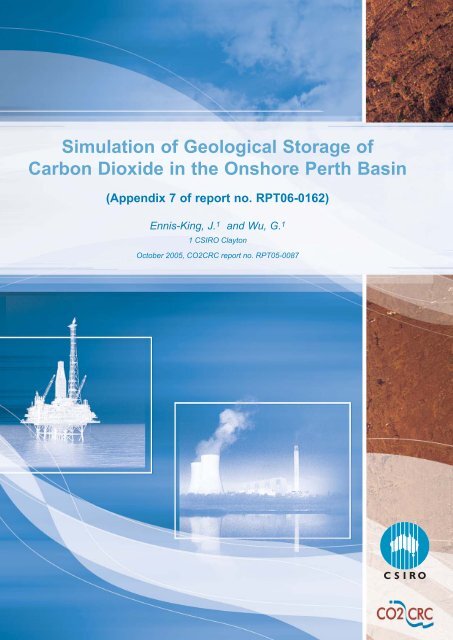
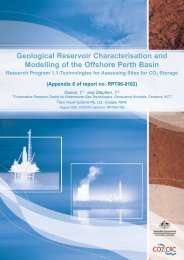
![Post-combustion solvent absorption [PDF 438KB] - CO2CRC](https://img.yumpu.com/48575763/1/184x260/post-combustion-solvent-absorption-pdf-438kb-co2crc.jpg?quality=85)

